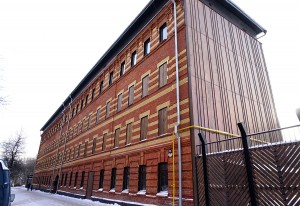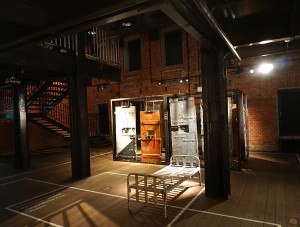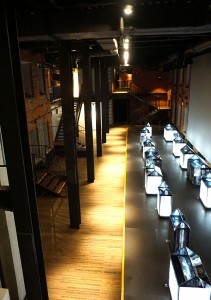 Moscow’s Gulag History Museum has moved to a new, larger, building with new exhibits and a new narrative.
Moscow’s Gulag History Museum has moved to a new, larger, building with new exhibits and a new narrative.
The building’s exterior is deliberately stark and austere, even forbidding. The interior exhibition space has been given a distinctly prison-like style. It is mostly one large multi-level hall, with many side rooms for specific topics.
 The Museum covers the history of the Gulag, describing the transition from the revolutionary optimism of 1917 to the harsh realities of the 1920s and 1930s, and then on through to Stalin’s death in 1953. There is a reasonable amount of English signage, although for some detailed topics there is only Russian. The exhibits start with a collection of cell doors and include various gulag artifacts and prisoner’s possessions. A side room shows videos (with English sub-titles) of now-elderly victims describing their arrests and trials.
The Museum covers the history of the Gulag, describing the transition from the revolutionary optimism of 1917 to the harsh realities of the 1920s and 1930s, and then on through to Stalin’s death in 1953. There is a reasonable amount of English signage, although for some detailed topics there is only Russian. The exhibits start with a collection of cell doors and include various gulag artifacts and prisoner’s possessions. A side room shows videos (with English sub-titles) of now-elderly victims describing their arrests and trials.
 I had been concerned that as part of the move to new quarters the Museum’s messages might have been softened, as has happened at Perm. But, no, the signage is very clear and crisp in describing the use of the Gulag system not merely for common criminals but as an instrument of political repression. Unusually for today’s Russia, there is a willingness to confront some of the harsher realities of the Soviet past. For example, the description of the Great Purge of 1937-1938 speaks freely of 1.5 million arrests and 700,000 executions.
I had been concerned that as part of the move to new quarters the Museum’s messages might have been softened, as has happened at Perm. But, no, the signage is very clear and crisp in describing the use of the Gulag system not merely for common criminals but as an instrument of political repression. Unusually for today’s Russia, there is a willingness to confront some of the harsher realities of the Soviet past. For example, the description of the Great Purge of 1937-1938 speaks freely of 1.5 million arrests and 700,000 executions.
I spent a couple of hours wandering around, reading the signs, watching the videos, and reflecting.
If you are interested in Soviet history, or in the impact of the past on today’s Russia, it is definitely worth a visit.
Practicalities: Here’s a link to the Gulag Museum Website. The Museum is at 1st Samotechny per., 9, bld. 1, Moscow. The nearest metro is Dostoyevskaya.